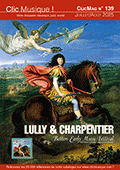 Ce CD édité par NDR Kultur réunit plusieurs oeuvres de Mozart transcrites pour un quintet d'instruments à vent (cor, basson clarinette, hautbois et flute ) auxquels s'adjoint, à deux reprises, le piano. On y trouve l'Ouverture du Directeur de théâtre K. 486, le Concerto pour piano en sol majeur K. 453, la Symphonie n° 26 en mi bémol majeur K. 184 et le Quintet pour piano, hautbois, clarinette, cor et basson en mi bémol majeur K. 452. Ces réductions (sauf dans le cas du Quintet) qui peuvent se réclamer de l'attachement de Mozart pour cette formation, l'ensemble des bois, attesté par quelques chefs d'oeuvres (la Symphonie concertante, la Sérénade "Gran partita"), se trouvent ici justifiées à l'écoute par le charme et l'élégance du rendu sonore. Certes, dans le cas des oeuvres écrites pour l'orchestre, le changement de perspective peut s'accompagner du sentiment d'un certain dénuement (particulièrement pour la Symphonie), mais il se révèle rapidement séduisant. Dans un autre format, avec d'autres couleurs, le chant mozartien ne subit aucune amputation et demeure pleinement présent, moins solennel, émis dans un climat d'intimité. Une joie discrète émane de ces pièces qui offrent un réconfortant compagnonnage musical, l'amitié d'un Mozart ! (Alain Letrun)  “Playing with other instruments is always fascinating: it’s not only great fun, but also an important experience for me as a pianist, every time. The piano is actually just a mechanical toolbox that we can operate without having to use our breath. Thanks to its mechanism, the sound is immediately produced; once the hammers have struck, it can no longer be influenced, and the note unavoidably fades away. It is thus essential for a pianist to imagine what it is like to play another instrument, and to study the sound of other instruments in depth. They can be wind or string instruments, or the human voice. Sometimes I imagine I am playing with a string quartet; at other times it can be a full orchestra. With a woodwind quintet as musical partner, I cannot help but breathe with the music: my colleagues are constantly putting that ability on display. It starts with the very first attack. If I just “played piano” as usual, we would never be together on the beat; thanks to the piano’s immediate mechanism, my note would always be there a little earlier. But if I imagine the gentle attack of a bassoon or a clarinet while listening closely, I can make an attempt not to be overly “on time” when I strike the key. I can also execute certain chords as a quick arpeggio, with the notes not quite together. Of course, such a mental image of breathing while playing can also be of great help when I am giving solo recitals: imagining wind attacks, or the upbow and downbow on the violin. The piano is an instrument designed to create illusion: the toolchest produces the most wonderful things, but to achieve them, we, as players, are required to use our imagination.....“ (from the remaks, written by the artists)
 |
